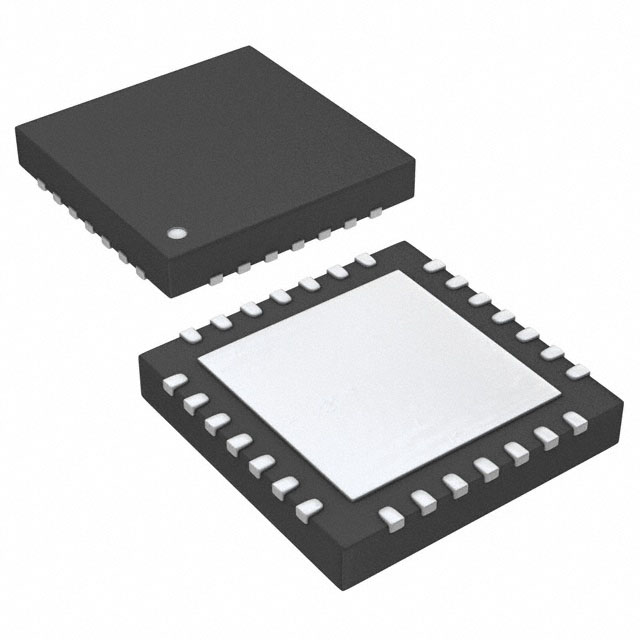PIC16LF1782-I/MV
Basic Information Overview
- Category: Microcontroller
- Use: Embedded systems, control applications
- Characteristics:
- Low power consumption
- High performance
- Enhanced peripherals
- Wide operating voltage range
- Package: 28-pin QFN
- Essence: A powerful microcontroller designed for embedded control applications.
- Packaging/Quantity: Available in reels of 2500 units.
Specifications
- Architecture: 8-bit
- CPU Speed: Up to 32 MHz
- Program Memory Size: 14 KB
- RAM Size: 1 KB
- Data EEPROM Size: 256 bytes
- Number of I/O Pins: 25
- ADC Channels: 11
- Timers: 3
- Communication Interfaces: UART, SPI, I2C
- Operating Voltage Range: 1.8V to 5.5V
- Temperature Range: -40°C to +125°C
Detailed Pin Configuration
The PIC16LF1782-I/MV microcontroller has a total of 28 pins. The pin configuration is as follows:
- RA0 - Analog Input / Digital I/O
- RA1 - Analog Input / Digital I/O
- RA2 - Analog Input / Digital I/O
- RA3 - Analog Input / Digital I/O
- RA4 - Digital I/O
- RA5 - Digital I/O
- VSS - Ground
- MCLR/VPP - Master Clear / Programming Voltage
- VDD - Power Supply
- RC0 - Digital I/O
- RC1 - Digital I/O
- RC2 - Digital I/O
- RC3 - Digital I/O
- RC4 - Digital I/O
- RC5 - Digital I/O
- VSS - Ground
- OSC1/CLKIN - Oscillator Input / External Clock Input
- OSC2/CLKOUT - Oscillator Output / Clock Output
- RC6 - Digital I/O
- RC7 - Digital I/O
- RB0 - Digital I/O
- RB1 - Digital I/O
- RB2 - Digital I/O
- RB3 - Digital I/O
- RB4 - Digital I/O
- RB5 - Digital I/O
- VDD - Power Supply
- VSS - Ground
Functional Features
- Enhanced Capture/Compare/PWM (CCP) module for precise timing control.
- Analog-to-Digital Converter (ADC) with 11 channels for accurate analog measurements.
- Enhanced USART module for serial communication.
- SPI and I2C modules for interfacing with other devices.
- Three timers for various timing functions.
- Low-power sleep mode for energy-efficient operation.
- Brown-out Reset (BOR) to ensure reliable operation during power fluctuations.
Advantages and Disadvantages
Advantages: - Low power consumption makes it suitable for battery-powered applications. - High-performance CPU allows for efficient execution of control algorithms. - Wide operating voltage range enables compatibility with different power sources. - Enhanced peripherals provide flexibility in system design.
Disadvantages: - Limited program memory size may restrict the complexity of the application. - Limited RAM size may impose constraints on data storage and manipulation. - Only 8-bit architecture, which may not be sufficient for certain advanced applications.
Working Principles
The PIC16LF1782-I/MV microcontroller operates based on the Harvard architecture, where program memory and data memory are separate. It executes instructions stored in the program memory and manipulates data stored in the RAM. The CPU fetches instructions from program memory, performs calculations, and controls the peripherals to carry out the desired tasks. The microcontroller can communicate with external devices through various communication interfaces and perform analog-to-digital conversions using the built-in ADC.
Detailed Application Field Plans
The PIC16LF1782-I/MV microcontroller is widely used in various embedded control applications, including but not limited to: - Home automation systems - Industrial control systems - Automotive electronics - Medical devices - Consumer electronics
Detailed and Complete Alternative Models
- PIC16LF1783-I/MV: Similar to PIC16LF1782-I/MV but with additional features such as more program memory and I/O pins.
- PIC16LF1784-I/MV: Similar to PIC16LF1782-I/MV but with higher RAM size and additional peripherals.
- PIC16LF1786-I/MV: Similar to PIC16LF1782-I/MV but with more program memory, RAM, and I/O pins.
- PIC16LF1787-I/MV: Similar to PIC16LF1782-I/MV but with enhanced analog capabilities and additional communication interfaces.
These alternative models offer different combinations of features to cater to specific application
Senaraikan 10 soalan dan jawapan biasa yang berkaitan dengan aplikasi PIC16LF1782-I/MV dalam penyelesaian teknikal
What is the operating voltage range of PIC16LF1782-I/MV?
- The operating voltage range of PIC16LF1782-I/MV is 1.8V to 3.6V.Can PIC16LF1782-I/MV be used in battery-powered applications?
- Yes, PIC16LF1782-I/MV is suitable for battery-powered applications due to its low power consumption.What are the key features of PIC16LF1782-I/MV?
- Some key features of PIC16LF1782-I/MV include nanoWatt XLP technology, multiple communication interfaces, and analog peripherals.Is PIC16LF1782-I/MV suitable for motor control applications?
- Yes, PIC16LF1782-I/MV can be used in motor control applications with its integrated PWM modules and high-resolution timers.Can PIC16LF1782-I/MV be programmed using C language?
- Yes, PIC16LF1782-I/MV can be programmed using C language with the MPLAB XC8 compiler.What development tools are available for PIC16LF1782-I/MV?
- Development tools such as MPLAB X IDE and PICkit programmers are available for PIC16LF1782-I/MV.Does PIC16LF1782-I/MV have built-in security features?
- Yes, PIC16LF1782-I/MV offers security features such as code protection and data EEPROM memory.What is the maximum clock frequency supported by PIC16LF1782-I/MV?
- PIC16LF1782-I/MV supports a maximum clock frequency of 32 MHz.Can PIC16LF1782-I/MV be used in temperature sensing applications?
- Yes, PIC16LF1782-I/MV can be used in temperature sensing applications with its analog-to-digital converter (ADC) and temperature indicator module.Are there any application notes available for using PIC16LF1782-I/MV in technical solutions?
- Yes, Microchip provides application notes and technical documents to guide users in implementing PIC16LF1782-I/MV in various technical solutions.


